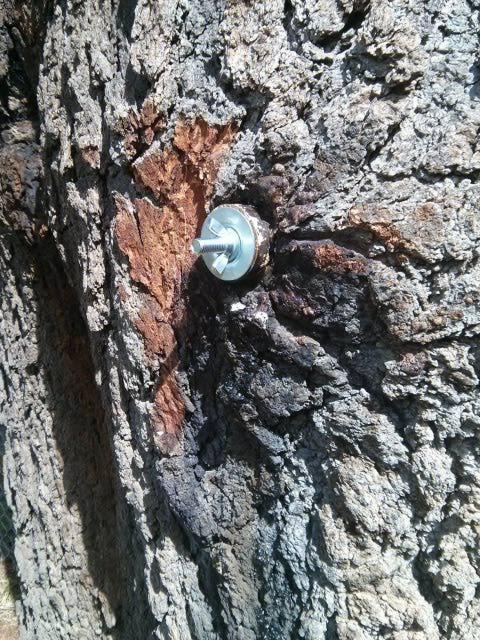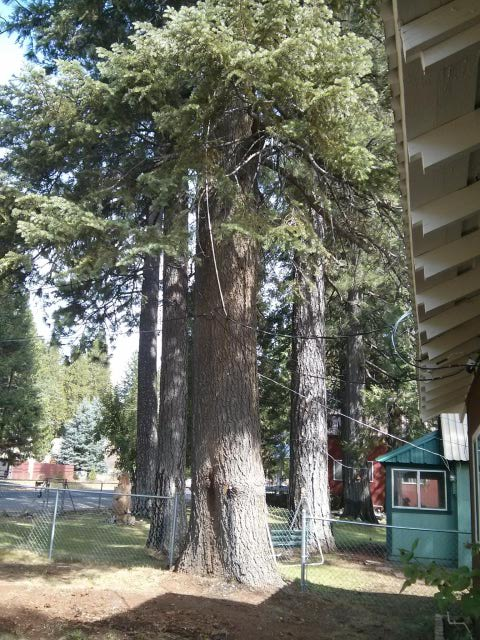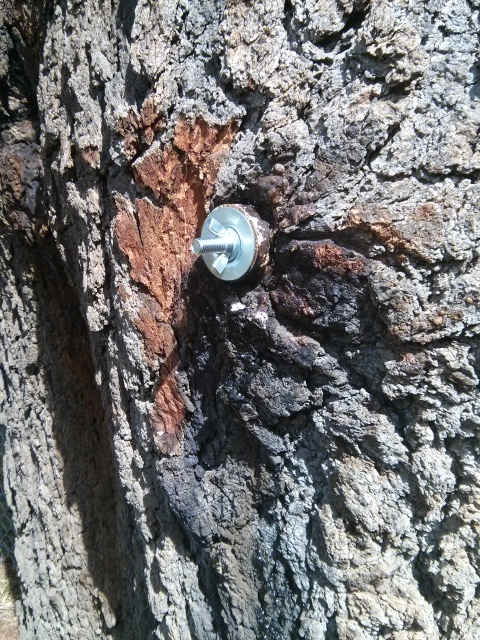Question Closeup of the plug an
Closeup of the plug an
 Douglas Fir, I believe
Douglas Fir, I believe
QUESTION: I have a healthy conifer that looks to be a douglas fir from pics I've seen. It's about 15 feet in circumference, 3-4 feet in diameter at eye level. In my front yard more than 50 years ago, somebody put a 1-7/8 inch steel pipe into the side of this tree and attached the other end of the pipe in likewise fashion into a ponderosa pine. (We played on the bar when we were kids.) The pine had to be taken down secondary to beetles about 30 years ago, but it was left intact at the level of the bar. My new landscaping fellow noted that the tree was mostly rotted and took it down, which necessitated sawing off the bar where it goes into the fir. When his saw hit the pipe, he said water came out under pressure, "like a sprinkler." The pipe had a fair amount of a black, tarry sludge sitting in the bottom of it, and it did slope very slightly downward, toward the earth. I hosed out the pipe till the water returned clear. The guy said that air would rot trees and that we should cover the pipe back up, which made sense since it's been in there 50+ years without harming the tree. We put a piece of foam pipe insulation as far down into the pipe as possible (only about 18 inches, and I measured it to go back 30 inches into the tree), and then he capped it with Fix-All patching compound. All seemed good till the next day. The white Fix-All had turned brown and it was dripping water, though his seal had been tight. This "water" (by the way) stinks terribly, but I've smelled this odor by the tree for years. I just never realized where it was coming from. (The liquid does evaporate away, though I believe it is leaving a black residue on the sparse grass at the base of the tree, so it seems to be probably 99% water.) I panicked at the thought of losing this massive tree (and the huge financial burden that taking it down would necessitate), and my brother suggested I get a better plug, which I did: the steel and rubber type, with an expandable inner core so that the seal is now quite tight. However, the next morning, it was dripping again, but only about half as fast (approx 1 drip per second or two). Tonight (nearly five 24-hour periods later), I find that it is still dripping, but more slowly. It still STINKS. So yesterday I talked to two certified arborists and got two different opinions on how to proceed. One said to leave the pipe PLUGGED and let the tree heal itself, which he was confident it would do, and the other arborist said to leave it UNPLUGGED and let the water drain out so that the tree could heal itself. We are in the 3rd year of drought in California and evidently it's not uncommon for there to be a gusher inside a tree of this size, though I do not really understand the specifics of that. So my question is threefold: 1. In order to preserve the health of this tree, should the pipe be left plugged to keep the air OUT by allowing the water pressure to build back up, or should it be allowed to drain so that air will be allowed IN, to reach the inside of this massive tree? Which will actually allow this tree to heal in the best possible manner? 2. Is there anything I can do about the awful smell of the pitch or water that is oozing out of the tree? I don't actually see any pitch, but there is a blackish stain where the watery-consistency liquid drip has been running down the tree. Would it hurt the tree if I were to attempt to seal this "bleed" at some point, and is there anything that could even be used to seal it off? 3. What's the thing about the gusher inside of a tree? From what I've gleaned online, it is usually pitch that comes spewing out of hot trees in the summer, but this was not pitch. It did not damage my landscaper's saw or cause a sticky mess of any kind -- just the stink of the water. Thank you so much for helping me in whatever way you can. I am in the Sierra Nevada range in Northern California, Butte County, at 3500 feet elevation, by the way, if it matters to you at all.
ANSWER: This is a complicated set of questions and I will try to answer what I can. First a little biology: The water and minerals move up the tree with pressure for the from the growth of the foliage. Larger trees have a good deal of pressure in order to get the water from the roots to the foliage. Here is a site link that explains this process. http://www.scientificamerican.com/article/how-do-large-trees-such-a/
The thing about the air is not really true. It is true that fungi need food, water and air to grow. but decay fungi will survive in the wood of a tree with the little oxygen they get fro the cells. To get the decay fungi started it would need an entrance through the bark cells layer. More than likely the decay fungi is in the woody cells and over many, many years will cause the tree to become hollow. BUT this is not a big problem since the tree is healthy and the trunk can support the tree even being hollow. It is not a problem to the survival of the tree and the decay fungi will not kill the tree.
Now to the questions.
1. I do not think the plugging or not plugging of the tree will make any difference to the health of the tree. The problem for you is the smell of the liquid. So I would leave the plug in and over time it should stop and over many years heal over the wound.
2. there is not much that can be done about the smell. This is the chemical makeup of the water and the color will depend on the tree species. It will not hurt the tree if you continue trying to seal the pipe off.
3. the gusher is normal pressure of the tree circulation system to move the water fro the roots to the foliage to manufacture food.
I am sorry I can not give you real detail answers but with out being there ii is hard to give you details. I think you are going about this correctly and will be able to stop the leaking soon. I hope this helps some.
---------- FOLLOW-UP ----------
 the pressure plug I us
the pressure plug I us
QUESTION: thank you very much for teaching me what you know. I feel much better about it at this point! One followup question: Is the water pressure inside the tree enough that I need to be concerned about it blowing the plug out of the pipe?
AnswerThe short answer is no. It is a complicated process moving water from the roots to the top of a tree. Here is another web link to describe this action. I would not worry about the plug blowing out. http://www.davidlnelson.md/Cazadero/Trees&CapillaryAction.htm








